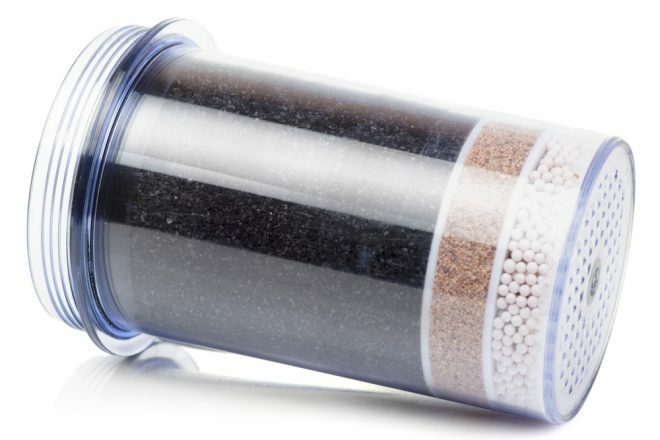Recently, the problem of clean water has been of great interest to the population of the entire planet. The demand for wastewater treatment plants is growing every year. Moreover, the most popular tool is an ordinary household filter. If earlier only residents of cities needed it, now residents of villages and settlements also actively use it. Not everyone can afford to purchase new filters on a regular basis (which are not cheap), so the question of how to make water filters with your own hands is extremely relevant.
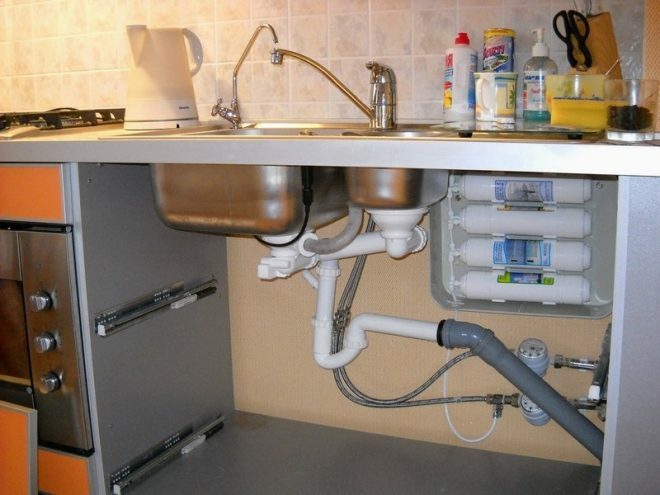
Features of homemade filters
At first glance, the tap water appears clean. In fact, there are many dissolved compounds in it. The water filter is designed to "retain" these substances: compounds of chlorine, iron, etc. Their excess can lead to the development of various diseases, as well as affect the general condition of the body.
Attention! Earned on our website kitchen designer. You can familiarize yourself with it and design your dream kitchen for free! May also come in handy wardrobes designer.
What about well water? Many people believe that it does not require cleaning, and they would be wrong. It can contain nitrates, a large number of bacteria, pesticides (seep through the treated soil). Also, the structure of the well can corrode. All this affects the taste and useful qualities of water.
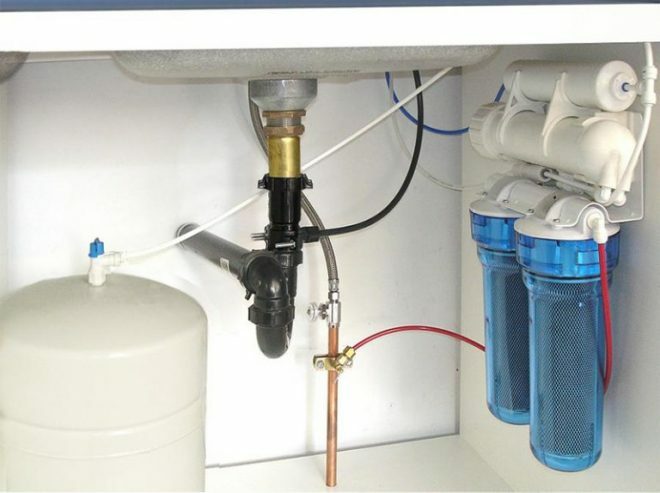
It is not necessary to buy expensive store devices - a homemade water filter is capable of good cleaning.
Of course, if you want crystal clear water, it is better to purchase a modern system after a while. This is due not so much to wear of parts, but to a lower absorbent and cleaning ability in relation to bacteria.
In homemade designs, there is no function of selecting a suitable mineral composition for the equipment. And this must be taken into account to ensure the sterility of the water. For this reason, the filtrate should be boiled after each filtration process.
Also, the water pressure during cleaning plays a huge role. An unsuitable pressure head in relation to the filter system reduces performance.
It is not recommended to make a flow-through water filter with your own hands, as it is unprofitable - a ready-made stationary system is more profitable.
How to choose a container and filter media
When choosing a container for a filter, you need to take into account that it will contain several layers of filler. The material of the tank must be resistant to external aggressive influences. If you need a household household filter for drinking water, then you need to choose high-quality polymer materials suitable for storing food for a long time.
Combinations of some of the following fillers are used to create the filter mixture:
- cotton wool;
- charcoal (activated, charcoal);
- sand (river, quartz);
- cellulose wipes;
- fabric made of natural material;
- lutrasil, spunbond;
- gravel, zeolite.
All of the above fillers have slightly different properties, therefore they are located at different levels in the filter when combined. However, only one of them can be selected and used. Next, we will analyze the properties of the most suitable materials.

River or quartz sand
Let's figure out how quartz sand differs from river sand:
- Quartz has a more homogeneous composition.
- It is able to retain more particles due to the optimal porosity in the space between the "grains".
Nevertheless, river sand has a significant advantage as a filtration filler - the high strength of the sand grains. That is, it is more durable.
Sand is used at the stage of filtration of heavy metals and small particles. Most often, the choice towards quartz is made when constructing a filter for a pool, because quartz sand is able to provide filtration of a sufficiently large water reservoir.
It will not be difficult to build such a unit, because it has a simple device. The savings compared to an industrial filter are approximately 50%.
The quartz sand fraction should be in the range of 0.4 to 0.8 mm. You can make a multilayer version, where the layers are arranged according to the size of the fraction - from larger to smaller, or where each layer is any other filler. It is important to find a middle ground here. Too fine sand fraction will clog the mesh, and the system will stop working, and too coarse fraction will negatively affect the quality of cleaning.
Charcoal or coconut shell
Coconut shell charcoal (activated) is obtained as a result of thermal and chemical processing of the original raw materials. It is sold in 3 types: pressed, free-flowing and granular. For the water treatment system, it is the latter that is purchased. The pressed and free-flowing types of active carbon are not suitable as an adsorbent. The particles of the former are too coarse and therefore do not provide optimal cleaning, while the particles of the latter will get into the water.
Most industrial filters are based on activated carbon. In order not to overpay, you can make a charcoal water filter with your own hands. Only the periodic purchase of fresh coal will remain from the expenses. Due to the water passing through the filler (charcoal) many times, it changes its consistency and looks more like black thick mucus. This substance is a favorable breeding ground for bacteria.
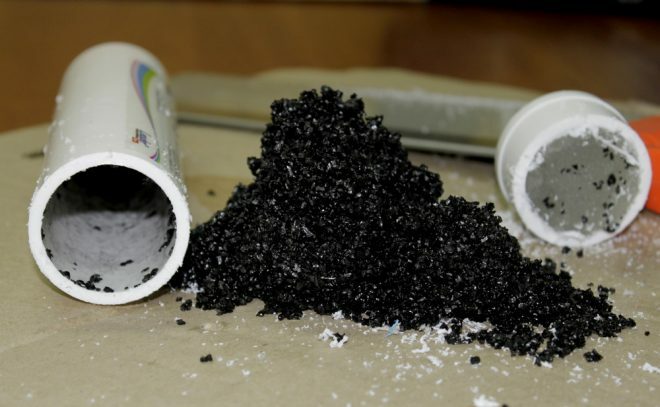
When it comes to industrial products, silver ions, known for their antibacterial properties, are usually added to them, which helps to prolong the life of the carbon filter. It is clear that when assembling a homemade filter, no one will deal with silver ionization. You need to remember this and change the filter with sufficient frequency - as soon as it becomes noticeable that the water is filtered more slowly.
When making charcoal yourself, you need to carefully calculate the degree of "roasting". If this degree is strong, then the coal will quickly lose its ability. Deciduous trees, especially birch, are most suitable. Conifers are not the best option, as resin can give the water a flavor.
Charcoal production is extremely simple. All you need to do is place the wood in a metal container and heat it over an open fire or in an oven until it is red-hot. After that, the material is removed and cooled in air.
Lutrasil and Spunbond
These synthetic materials are composed of polypropylene fibers. In fact, it is agrofibre. It is often used in plant growing to cover the soil in the fight against weeds, due to its ability to pass water and air well through itself. Lutrasil and spunbond differ in color and density. Lutrasil is slightly thinner than spunbond, has a white color, and spunbond, on the contrary, is black and denser fabric.
To create filters, lutrasil is more often chosen, since it is easier to determine the degree of filter contamination by it, and it also passes water through itself faster due to its lower density, which is especially important if there is more than one in the filter layer.
Making a charcoal water filter with your own hands
We remind you that this is more of a "travel option" and is not entirely suitable for daily use, as it requires frequent replacement. Nevertheless, for those who do not have the opportunity to regularly buy a cartridge, we suggest that you familiarize yourself with the method of manufacturing a homemade device. It can be used in the country, since no plumbing is required (filtration as in a jug mechanism).
- We choose a plastic tank as a container for finished water. If the system is planned to be used in the long term, then the plastic must be of high quality in order to avoid the entry of harmful substances into the water (common PET will not work).
- A container that will act as a cartridge (a tank with untreated water) can be made from any plastic bottle. The bottom is cut off.
- To connect 2 containers, make a hole in the lid of the bucket equal to the diameter of the bottle neck. If the neck does not fit into the hole, the cut diameter must be increased. If, on the contrary, you overdid it with the cut out diameter, you need to wrap the neck with something that does not allow moisture to pass through. It can be rubber, or some kind of dense synthetic fabric.
- As a base, cheesecloth is usually put in several layers. Next, activated granular carbon is poured. The layers of coal can be diluted, for example, with washed river sand, quartz.
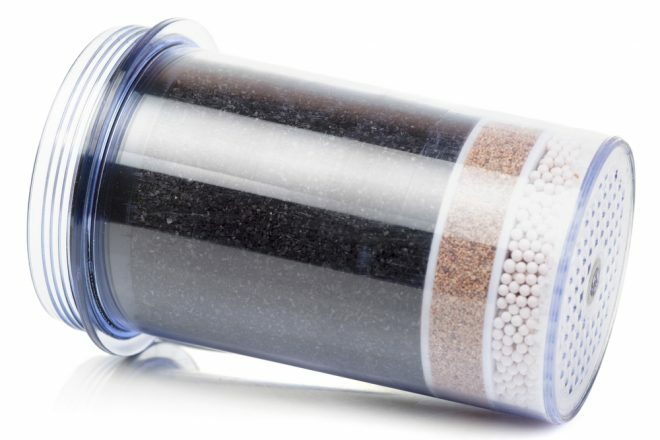
A DIY water filter doesn't have to be small. At home, it is quite possible to make a system of relatively large volume. For example, let's take a 10 liter plastic barrel as a loading container. It has a wide neck, so the filler will spill easily. In this case, the cartridge is made differently.
- From one end of a plastic pipe with a diameter of 4 cm, we make a tight filling of gauze.
- On the other side of the pipe, we lay activated carbon and in the same way we make a stuffing of gauze.
It remains to insert the filter cartridge into the neck of the upper container (into which we fill in untreated water). We chose the 4 cm pipe, because this particular diameter is ideal for a standard 10 l barrel, no additional sealing is needed.
The service life and features of the operation of a charcoal homemade filter
The more dissolved substances in the water, the less the device will last (this applies to both home-made and commercial filters). As already mentioned, soaked coal is a breeding ground for bacteria. Thus, the service life of this material is short in any case. On average, you need to fill up a new portion every 3 days. But this is only if the water quality has not deteriorated.
An important point: when using charcoal, the water after the first filtration must be drained. If coal from coconut shells is taken as a filler, this is not necessary - it is completely safe.
Conclusion
There is nothing special about commercial water purification devices - you can get the same or even better results using the tools at hand. The question is - will it be convenient to change the filler every 3-4 days? If yes, then you can safely use a homemade filter, if not, then the best choice is an industrial product.
average rating 0 / 5. Number of ratings: 0
No ratings yet. Be the first to rate.
